Benefits of white activated charcoal. Side effects of activated charcoal
Activated charcoal is a tool that can still be found in almost any home first aid kit. Due to its high activity and ability to remove harmful elements from the body, this drug is excellent for various poisonings, slagging of the body, and allergic reactions.
When to take activated charcoal
Activated charcoal is a popular remedy for quickly removing toxins from the body. The drug helps with poisoning caused by food, plant poisons, drugs, chemicals. Research shows that Activated carbon halves the absorption of harmful substances in the intestines.
Activated charcoal is used for overeating - the drug will help the intestines to clear out more quickly. An adsorbent is often used if a feast with alcohol is planned. A couple of charcoal tablets drunk in advance will help neutralize some of the toxins that enter the body when drinking alcohol. For the same reason, activated charcoal is taken with a hangover, drinking tablets with plenty of water.
The drug helps well with problems with the gastrointestinal tract, such as flatulence and intestinal colic. Activated charcoal is effective for diarrhea, including if the indigestion was caused by an intestinal infection.
Activated charcoal can be taken in courses in the treatment of chronic diseases. Also, the adsorbent relieves allergy symptoms due to its ability to remove toxins.
In general, activated charcoal is a harmless drug, but it is worth remembering that, along with the removal of harmful substances, it interferes with the absorption in the stomach of the elements necessary for the body - vitamins, proteins, minerals. Therefore, the drug is not recommended for long-term use.
Operating principle
Activated charcoal is an extremely active drug. As we have already found out, it can absorb various substances, including toxins. This effect occurs due to the process of adsorption. Activated charcoal binds harmful elements, after which they are removed from the digestive tract. The drug cannot neutralize substances that have already been absorbed into the blood, but it perfectly absorbs impurities that have not yet been adsorbed by the body.
Instructions for use
The drug is most often used for oral administration. Activated charcoal has no smell or taste. Available in different forms: in the form of tablets, capsules, granules, pastes and powder.
In addition to the well-known name (“activated carbon”), the drug is also available under other names, such as microsorb-P, carbactin, enterosorbent, carbolong and others.
Activated charcoal is effective for intoxication, pollution of the body, diarrhea. It reduces absorption and helps to remove toxins, harmful compounds, various allergens. But the tool does not cope well with acids and alkalis. The advantages of the drug include the fact that it acts gently and does not irritate the mucous membrane.
Indications for use
- Poisoning by alcohol, psychotropic drugs, drugs, chemicals
- Food poisoning
- Problems with the gastrointestinal tract (flatulence, diarrhea, rotting food in the stomach)
- Chronic diseases such as hepatitis, liver cirrhosis, kidney failure
- Metabolic disease
- allergic reactions
- During the recovery of the body after chemotherapy and radiotherapy
Contraindications for use
- Ulcerative lesions of the stomach
- Gastrointestinal bleeding
- Nonspecific ulcerative colitis
- Activated charcoal is not used concomitantly with antitoxic drugs and certain drugs.
Side effects
Although activated charcoal is considered a harmless drug, its uncontrolled use can lead to some unpleasant consequences. Excess substances in the body can disrupt the functioning of the organs of the gastrointestinal tract, in particular, cause diarrhea, constipation. Long-term use of the drug can provoke a lack of vitamins, reduce the level of calcium in the blood, cause low blood pressure, dispersion, hypoglycemia.
Formula: Cn, chemical name Carbon
Pharmacological group: metabolic/detoxifying agents, including antidotes; adsorbents
Pharmachologic effect: adsorbent, detoxifying, antidiarrheal.
Pharmacological properties
Activated carbon is characterized by high surface activity, which determines the ability to bind substances that lower surface energy (without changing their chemical nature). Sorbs gases, toxins, alkaloids, glycosides, salts of heavy metals, salicylates, barbiturates and other compounds, reduces their absorption in the gastrointestinal tract and promotes excretion from the body with feces. Active as a sorbent during hemoperfusion. Weakly adsorbs acids and alkalis (including iron salts, cyanides, malathion, methanol, ethylene glycol). Does not irritate mucous membranes. When applied topically in a patch, it increases the rate of healing of ulcers. For the development of the maximum effect, it is recommended to enter immediately after poisoning or during the first hours. In the treatment of intoxication, it is necessary to create an excess of coal in the stomach (before washing it) and in the intestines (after washing the stomach). The presence of food masses in the gastrointestinal tract requires the introduction of high doses, because. the contents of the gastrointestinal tract are sorbed by carbon and its activity is reduced. A decrease in the concentration of coal in the medium contributes to the desorption of the bound substance and its absorption (to prevent the resorption of the released substance, repeated gastric lavage and the appointment of coal are recommended). If the poisoning is caused by substances involved in the enterohepatic circulation (cardiac glycosides, indomethacin, morphine and other opiates), it is necessary to use coal for several days. It is especially effective as a sorbent for hemoperfusion in cases of acute poisoning with barbiturates, glutathimide, theophylline.
Indications
Dyspepsia; diseases accompanied by processes of decay and fermentation in the intestines (including flatulence); increased acidity and hypersecretion of gastric juice; diarrhea; acute poisoning (including alkaloids, glycosides, salts of heavy metals); diseases with a toxic syndrome - food poisoning, dysentery, salmonellosis, burn disease in the stage of toxemia and septicotoxemia, hyperazotemia (chronic renal failure), hyperbilirubinemia (chronic and acute viral hepatitis, cirrhosis of the liver); allergic diseases; bronchial asthma; atopic dermatitis; preparation for x-ray and ultrasound examinations (to reduce gas formation in the intestines).
Method of application of activated carbon and doses
Take orally, in tablets or as an aqueous suspension (the required amount of the drug is mixed in 0.5 cups of water), 1 hour before meals and other medications. Adults on average 1.0-2.0 g 3-4 times a day, the maximum dose for adults is up to 8 g. Children are prescribed an average of 0.05 g / kg of body weight 3 times a day, the maximum single dose is up to 0.2 mg/kg body weight. The course of treatment for acute diseases is 3–5 days, for allergies and chronic diseases- up to 14 days. Repeated course - after 2 weeks on the recommendation of a doctor.
In acute poisoning - gastric lavage using a suspension of activated charcoal, then inside 20–30 g. In case of flatulence and dyspepsia - inside 1–2 g 3–4 times a day. The course of treatment is 3–7 days.
The course of treatment for diseases accompanied by the processes of fermentation and putrefaction in the intestines, increased secretion of gastric juice, lasts 1-2 weeks. Adults - 10 g 3 times a day between meals, children under 7 years old - 5 g each, 7–14 years old - 7 g per reception.
If you missed the next dose of medication, you can take activated charcoal as soon as you remember, but not earlier than one hour before eating or taking another medication. The time of the next medication should be shifted by the same interval.
Contraindications and restrictions for use
Ulcerative lesions of the gastrointestinal tract (including exacerbation of gastric and duodenal ulcers, ulcerative colitis), bleeding from the gastrointestinal tract, intestinal atony, simultaneous administration of antitoxic substances, the effect of which develops after absorption (methionine, etc.), hypersensitivity, constipation. Long-term use of activated charcoal disrupts the normal activity of the stomach, which can lead to difficult and painful digestion.
Use during pregnancy and lactation
The drug is non-toxic and is not absorbed into the blood. In the recommended doses, the contraindications are the same.
Side effects of activated charcoal
Dyspepsia, constipation or diarrhea, black-colored stools; with prolonged use (more than 14 days), malabsorption of calcium, fats, proteins, vitamins, hormones, nutrients is possible; with hemoperfusion through activated charcoal, embolism, hemorrhage, hypoglycemia, hypocalcemia, hypothermia, and a decrease in blood pressure may develop.
Interaction of activated carbon with other substances
Activated charcoal reduces the absorption and effectiveness of drugs taken orally at the same time as it; reduces the activity of intragastrically active substances (for example, ipecac).
It is recommended to store in a dry place, away from substances that release gases or vapors into the atmosphere. Storage in air (especially in a humid environment) reduces the sorption capacity.
Overdose
Data on a possible overdose of activated charcoal have not been reported.
Activated charcoal is a detoxifying drug, an adsorbent. This is the most affordable enterosorbent, which is used to cleanse the body of allergens, toxins, toxins. Activated charcoal is widely used for weight loss as an aid, as well as in the treatment of intestinal and skin diseases.
Composition and form of release of activated carbon
The main active ingredient is coal of vegetable or animal origin, subjected to special treatment. Available in the form of tablets of 0.25 and 0.5 g. The package contains 10 tablets.
Activated carbon analogues
The following medicines have a similar effect:
- Carbactin;
- Carbopect;
- Karbosorb;
- Lopedium;
- magnesium peroxide;
- Microsorb-P;
- Sorbex;
- Stoperan;
- Ultra-Adsorb;
- Cherry fruits.
Pharmacological action of activated carbon
Activated charcoal is an adsorbing, detoxifying, antidiarrheal drug with high surface activity, due to which substances that reduce surface energy are bound without changing their chemical nature.
Coal sorbs a number of compounds:
- alkaloids;
- barbiturates;
- gases;
- glycosides;
- salicylates;
- Salts of heavy metals;
- Toxins.
Under the action of activated carbon, their absorption in the gastrointestinal tract decreases and excretion from the body with feces is simplified.
As a sorbent, coal is active in hemoperfusion. Weak adsorption against acids and alkalis, including iron salts, cyanides, malathion, methanol, ethylene glycol. Does not irritate the mucous membranes, and in the case of topical application, activated charcoal accelerates the healing of ulcers.
In the treatment of intoxication, an excess of coal is created in the stomach (before washing it), as well as in the intestines (after washing the stomach).
High doses are required if there are food masses in the gastrointestinal tract: they are sorbed by coal, reducing its activity. A low concentration of the drug leads to desorption and absorption of the bound substance. Repeated gastric lavage and the appointment of activated charcoal, according to doctors, prevents the resorption of the released substance.
In cases where poisoning is provoked by substances that take part in the enterohepatic circulation (cardiac glycosides, indomethacin, morphine or other opiates), the tablets should be taken for several days.
The special effectiveness of the adsorbent is observed in hemoperfusion after acute poisoning with theophylline, glutethimide or barbiturates.
Indications for the use of activated carbon
Activated charcoal is indicated for the following diseases:
- Dyspepsia;
- Flatulence and other processes of putrefaction and fermentation in the intestines;
- Increased acidity and hypersecretion of gastric juice;
- diarrhea;
- Acute poisoning, including glycosides, alkaloids, salts of heavy metals;
- food poisoning;
- dysentery;
- Salmonella;
- Burn disease in the stage of toxemia and septicotoxemia;
- Chronic renal failure;
- Chronic and acute viral hepatitis;
- cirrhosis of the liver;
- Allergic reactions;
- Bronchial asthma;
- Atopic dermatitis.
Tablets are also prescribed to reduce gas formation in the intestines in preparation for ultrasound and x-ray examination.
It is allowed to use Activated Charcoal for Weight Loss as an aid after consulting a doctor and choosing an adequate diet.
Contraindications
Contraindications to the appointment of activated carbon are:
- High individual sensitivity;
- Peptic ulcer of the stomach and duodenum;
- Nonspecific ulcerative colitis;
- Bleeding from the gastrointestinal tract;
- intestinal atony;
- Simultaneous intake of antitoxic substances, the action of which begins after absorption.
How to use activated carbon
Tablets or an aqueous suspension of activated charcoal, according to the instructions, are taken orally 1 hour before meals and taking other medicines. To obtain a suspension, the required amount of the drug is mixed in 0.5 cups of water.
The average daily dose for adults is 1-2 g, and the maximum is 8 g. The dose for children is calculated based on body weight - 0.05 g / kg 3 times a day, but not more than 0.2 mg / kg at a time .
In acute diseases, the course of treatment lasts 3-5 days, and in allergic or chronic diseases - up to 2 weeks. After 14 days, therapy can be repeated according to the doctor's recommendations.
With dyspepsia or flatulence, activated charcoal is taken orally 1-2 g 3-4 times a day for 3-7 days.
Suspension is used for gastric lavage in acute poisoning. Then the solution is drunk for 20-30 g.
With increased secretion of gastric juice, adults need 10 g 3 times a day between meals, children under 7 years old - 5 g each, and children 7-14 years old - 7 g per dose. The course of treatment is 1-2 weeks.
Side effects of activated charcoal
Side effects of activated charcoal may include:
- Constipation;
- Diarrhea;
- Dyspepsia;
- Black chair color;
- Embolism;
- Hemorrhage;
- hypoglycemia;
- hypocalcemia;
- Hypothermia;
- Decreased blood pressure.
Long-term use can lead to malabsorption of fats, proteins, calcium, vitamins, hormones, nutrients;
drug interaction
Activated charcoal, according to reviews, worsens the absorption and effectiveness of drugs taken at the same time, and also reduces the activity of substances that act inside the stomach, for example, ipekuana.
Storage conditions
Activated carbon, according to the instructions, should be stored in a dry place and separately from substances that emit vapors or gases into the atmosphere. Storage in a humid environment and in the air reduces the sorption capacity of the drug.
In almost every home in the home first aid kit there is a tool that can cope with the intoxication of the body that occurs when food is poisoned or the abuse of alcoholic beverages. One of the most common and most well-known and inexpensive preparations is black activated charcoal. IN last years gained popularity drug-adsorbent, similar in properties to black coal, called "white coal", surpassing it in efficiency.
White and black activated carbon: the difference
The pharmaceutical industry produces two types of activated charcoal that help cleanse the intestines of unnecessary substances, but there are some differences between them:
- different composition;
- white coal is odorless, tasteless and is a new generation sorbent;
- after taking one tablet of the latest remedy, the symptoms of intoxication are removed;
- black coal has a low price;
- white coal has many contraindications;
- due to the presence of cellulose in the white coal tablets, there are no sensations of discomfort and heaviness in the stomach;
- the special composition of white coal tablets allows you to absorb more toxic substances.
A white charcoal tablet consists of the following substances:
- silicon dioxide in a superfine state (mineral particles have the smallest dimensions);
- powdered sugar;
- microcrystalline cellulose;
- potato starch;
- auxiliary ingredients necessary for the formation of the tablet.
Black coal is obtained by heating peat or charcoal in a special container without air.
The mechanism of action of white coal
White smallest particles of coal do not have pores and cannot absorb water, minerals and other useful substances, as other sorbents do, including black coal. 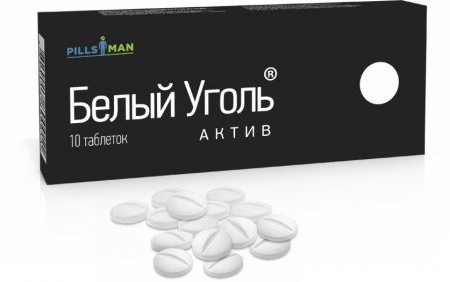 Coal particles, being attracted to the surface of microorganisms, surround them, and the microbes lose their ability to attach to the intestinal walls and, as a result, are excreted from the body. White charcoal attracts both small and large toxins and microbes that cause diarrhea or intestinal upset. White coal should be taken at a time 2-3 tablets, and black coal - 15-20. In white coal and black coal, the difference is that constipation and hypovitaminosis when taking the first one are not terrible.
Coal particles, being attracted to the surface of microorganisms, surround them, and the microbes lose their ability to attach to the intestinal walls and, as a result, are excreted from the body. White charcoal attracts both small and large toxins and microbes that cause diarrhea or intestinal upset. White coal should be taken at a time 2-3 tablets, and black coal - 15-20. In white coal and black coal, the difference is that constipation and hypovitaminosis when taking the first one are not terrible.
Advantages of white tablets
- It has two forms of release: tablets and powder.
- There are no contraindications for long-term use.
- The effect comes quickly after taking the drug.
- Does not affect the intestinal mucosa.
- Improves motor skills, does not contribute to constipation.
- A good anti-allergic agent.
- Small doses of the drug also have a therapeutic effect.
- The crushed tablet acts faster.
Indications for use
They are the same for both types:
- food poisoning, alcohol-containing drinks;
- diseases of the dermis;
- liver disease;
- gastrointestinal disorders;
- allergic conditions;
- kidney failure;
- pathology of the digestive system.
Application in childhood
The difference between white and black charcoal is that white tablets are contraindicated for use under 14 years of age, and there are no such restrictions for black ones. 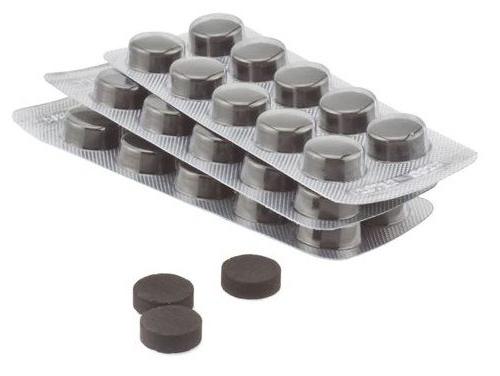 Children are given black charcoal in the amount of 0.05 g per kilogram of body weight up to three times a day before meals for about one hour.
Children are given black charcoal in the amount of 0.05 g per kilogram of body weight up to three times a day before meals for about one hour.
Application during pregnancy
With the problems of increased gas formation, intestinal disorders, preparations of activated black coal will help to cope. For ten kilograms of a woman's weight, one tablet is taken. Carefully use the drug for problems with the stool. The difference between white coal and black coal is that pregnant women are strictly forbidden to take a white drug.
Use for body cleansing
You can take both white and black coal for these purposes. Women like that after the use of coal, weight and body volume decrease, and men are pleased with the rapid elimination of toxins after taking a fairly large amount of alcohol.
And everyone notes that any coal increases efficiency, strengthens the immune system and normalizes sleep.
Activated charcoal white and black: differences when used to cleanse the body. Using black coal for these purposes, it is crushed in water or thoroughly chewed, just one tablet is enough for 10 kg of weight. 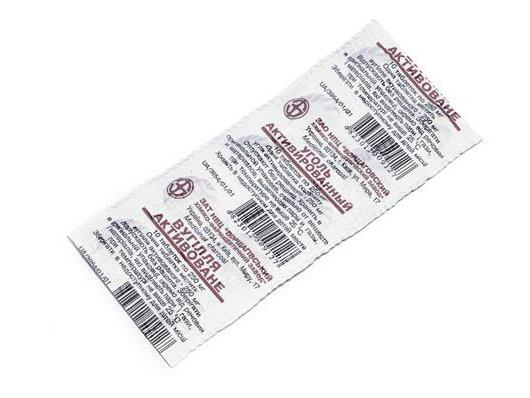 Take no more than three times a day. When using white coal from morning to evening, it is recommended to drink plenty of water and not eat. Instead of dinner, dissolve five crushed tablets in ½ cup of warm water and drink in small sips. The next morning, the tablets are taken again, their number depends on the weight.
Take no more than three times a day. When using white coal from morning to evening, it is recommended to drink plenty of water and not eat. Instead of dinner, dissolve five crushed tablets in ½ cup of warm water and drink in small sips. The next morning, the tablets are taken again, their number depends on the weight.
 30 minutes after taking coal, let's have a light breakfast and then lunch. Exclude for this time bread, dairy products, alcohol-containing drinks. Two-day cycles with the use of coal can be carried out several times during the year.
30 minutes after taking coal, let's have a light breakfast and then lunch. Exclude for this time bread, dairy products, alcohol-containing drinks. Two-day cycles with the use of coal can be carried out several times during the year.
Contraindications to the use of white tablets
- Intestinal obstruction.
- Exacerbation of peptic ulcer of the duodenum and stomach.
- Individual intolerance to the substances that make up the tablets.
- Gastric, intestinal bleeding.
- Pregnancy, lactation.
- Diabetes. In this disease, the drug is taken strictly according to the doctor's prescription.
- White charcoal and black charcoal: the difference is in the age limit. On the reception of white coal there is a ban on the use of up to 14 years.
Contraindications to taking black pills
- Ulcerative problems of the gastrointestinal tract.
- Simultaneous reception with antitoxic agents.
- Bleeding from the stomach.
- High sensitivity to the ingredients that make up the tablet.
A little more about the difference between white activated carbon and black
According to consumer reviews:
- White coal was named so to increase its sale in the pharmacy chain. The active substances-adsorbents - microcrystalline cellulose and silicon dioxide, which are part of the tablets, have a stronger and faster effect. In case of poisoning, it is convenient to use, does not stain your mouth and hands, you need few tablets, unlike traditional black coal.
- In white coal and black coal, the difference lies in the fact that white coal begins its action immediately after ingestion and does not hiss in the mouth. The action is fast, powerful and instant, unlike black coal.
- From a large number of drunk black coal tablets, unpleasant sensations arise in the form of nausea.
- Black coal is able to purify the air from various toxic substances, so it is used in gas masks.
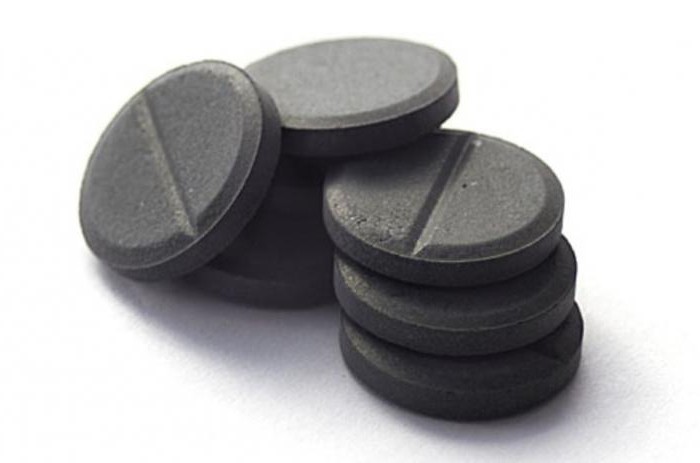 Despite the huge number of sorbents present on the modern pharmaceutical market, activated carbon has not lost its significance. There was also a new, so-called, its white appearance. What is the difference between white coal and black coal? Firstly, they have a different composition, and secondly, a list of contraindications for use.
Despite the huge number of sorbents present on the modern pharmaceutical market, activated carbon has not lost its significance. There was also a new, so-called, its white appearance. What is the difference between white coal and black coal? Firstly, they have a different composition, and secondly, a list of contraindications for use.
Which coal to choose? Right choice help to make a medical professional, your doctor.
In any home first aid kit, it is important to have an effective detoxifying agent that can quickly eliminate ailments and get rid of poor health. White coal is a modern enterosorbent that fully meets the requirements of medicine. Along with the drugs proven in the pharmacological market, the new drug has a higher degree of effectiveness.
What is white coal?
The drug belongs to the group of adsorbing medicines of the latest generation. It fully meets modern requirements for detoxification agents, and a high sorption degree is many times higher than that of activated carbon. White charcoal is a highly effective remedy for detoxifying the body and stopping diarrhea.
Composition and useful properties
This medication has a different composition from activated charcoal. It is based on a substance called silicon dioxide, which gives the drug a white color. It removes excess intestinal gases, gastric juice, bacterial and food allergens, chemical and microbial toxins, protein decay products from the body. Silicon dioxide moves and subsequently removes ethyl alcohol, salts of heavy metals, glycosides, organophosphorus compounds, serotonin, urea, lipids into the intestinal tract from the lymph and blood.As an additional component, the tablets contain microcrystalline cellulose, which is isolated from plant fiber. It does not dissolve in the intestines, but collects toxins, decay products, free radicals on its surface. This helps to improve parietal digestion in the small intestine, helps to remove the stagnation of the food bolus. Thanks to these components, the drug has a number of advantages:
- Does not damage the gastrointestinal mucosa, improves its functional state.
- Provides a fast therapeutic effect.
- Non-toxic and absolutely safe to use.
- Affects the reduction of symptoms of allergic reactions.
- Does not cause constipation, stimulates intestinal motility, contributing to the rapid elimination of toxins.
- It has a much lower daily dose than activated charcoal, which is 4 grams and is based on a larger sorption capacity of the drug.
- Does not require grinding, but in the form of a suspension has a higher degree of efficiency.
- Does not cause allergic reactions.
- Does not contain flavoring additives, has a neutral taste.
- It is not harmful when used for many months, does not cause hypovitaminosis, due to the selective action.
- Effective in small doses.
- It has several forms of release (tablets, powder for suspension).
Indications
The drug is used as a dietary supplement and is an additional source of enterosorbents that help relieve symptoms in renal and hepatic insufficiency, food poisoning of various origins (including alcohol and mushrooms), acute intestinal infections, helminthiases, gastric disorders, hepatitis (including viral hepatitis A and B). Promotes absorption from the gastrointestinal tract and excretion of endo- and exogenous toxic substances, food, bacterial allergens, reduces the manifestation of toxic-allergic reactions.
Method of application and dosage
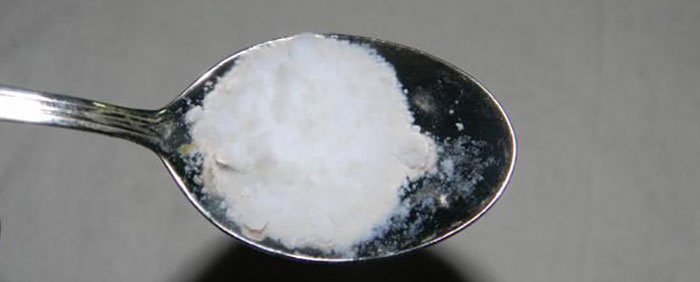
Children from 7 years old and adults are prescribed 3-4 times a day one hour before meals, 3-4 tablets of the drug. It is necessary to drink the medication with plenty of water. If the drug is in the form of a powder in a vial, then a suspension is prepared from it by adding 250 ml of chilled boiled water and thoroughly shaken. One measuring cap contains 1.15 g of the drug. The suspension is allowed to be used by children from 1 year old - 0.575 g each, from 7 years old and adults by 2.25 g 3-4 times a day between meals.
Contraindications
Gastric, intestinal bleeding, the presence of gastric ulcer, duodenal ulcer at the stage of exacerbation, erosion of the intestinal mucosa, pregnancy, intestinal obstruction, lactation, as well as individual intolerance to the components are reasons for refusing to use the drug. It is not a drug, therefore it is used in complex therapy. Before taking it is necessary to consult a doctor.
Which activated charcoal is better black or white
This question arises for everyone who learns about the existence of an analogue of the familiar activated carbon, which is the most common drug taken in case of poisoning. But modern medicine offers a more convenient and effective option. Silicon dioxide contained in white coal has a high adsorption capacity, and its tablets do not require mandatory grinding. This has the added benefit of being convenient and requiring less drug to consume than activated charcoal.
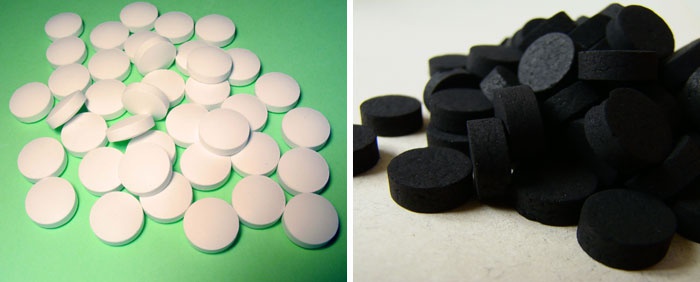
With food and alcohol poisoning
During intoxication of the body, it is necessary to take a sorbent that will quickly eliminate the unpleasant symptoms of poisoning. Nausea, vomiting, diarrhea, dizziness, headache will pass faster after using coal. Activated - you need to drink in large doses, but it will help to strengthen the stool faster with food poisoning. White - more effectively detoxifies the body from alcohol, quickly relieving headaches, and the dosage of this drug is several times less.
For allergies
In case of unpleasant manifestations of allergic reactions (urticaria, pain in the eyes, swelling, runny nose, sneezing, coughing), it is necessary to drink an adsorbent drug that will instantly cleanse the body of toxic substances. Therapy should be complex together with antihistamine drugs prescribed by a doctor. Which coal is better for allergies, white or activated, everyone chooses independently, depending on preferences. White is more efficient and faster to help deal with the problem, but its cost is slightly higher.
For weight loss
Adsorbents will be good helpers for weight loss. They help cleanse the body of toxins. In the evening they take a dose of the drug, according to the instructions, and the next day they drink a lot of water, herbal teas, compotes. Such fasting days will help to smoothly reduce weight. The problem is that the drugs used absorb not only harmful substances, but also useful ones, depriving a person of essential vitamins, minerals, and fats.

Absorbing the elements necessary for the body, activated charcoal leads to beriberi, and its modern colleague based on silicon dioxide has a lower ability to absorb nutrients, absorbing mostly toxins. This is an advantage when using a drug for weight loss. Purifying the body with any adsorbent, you must additionally take multivitamins to eliminate the likelihood of their deficiency.
During pregnancy
It is impossible to use silica-based charcoal during pregnancy, according to the instructions. It is better to replace it with an activated one, which will help get rid of frequent gas formation, colic, indigestion. But if the expectant mother has a tendency to constipation, black coal should be taken with caution. Calculate the required dose of the drug, based on the proportion: a tablet for every 10 kg of weight. Grind them into powder, fill with water until a suspension forms. So the drug will work faster and more efficiently.
children
The dose of the adsorbent for the child's body is calculated according to the weight of the child. Very infants are recommended sorbents in the form of a suspension, which is prepared from white or activated carbon. Both drugs are sold in powder form for suspension. But the sorption capacity of white charcoal is much higher than that of activated charcoal, which will help relieve the baby of pain faster. Black coal is given to children with the calculation of 0.05 g of the drug per kg of body weight, it should be taken 3 times a day, two hours before or after meals.


